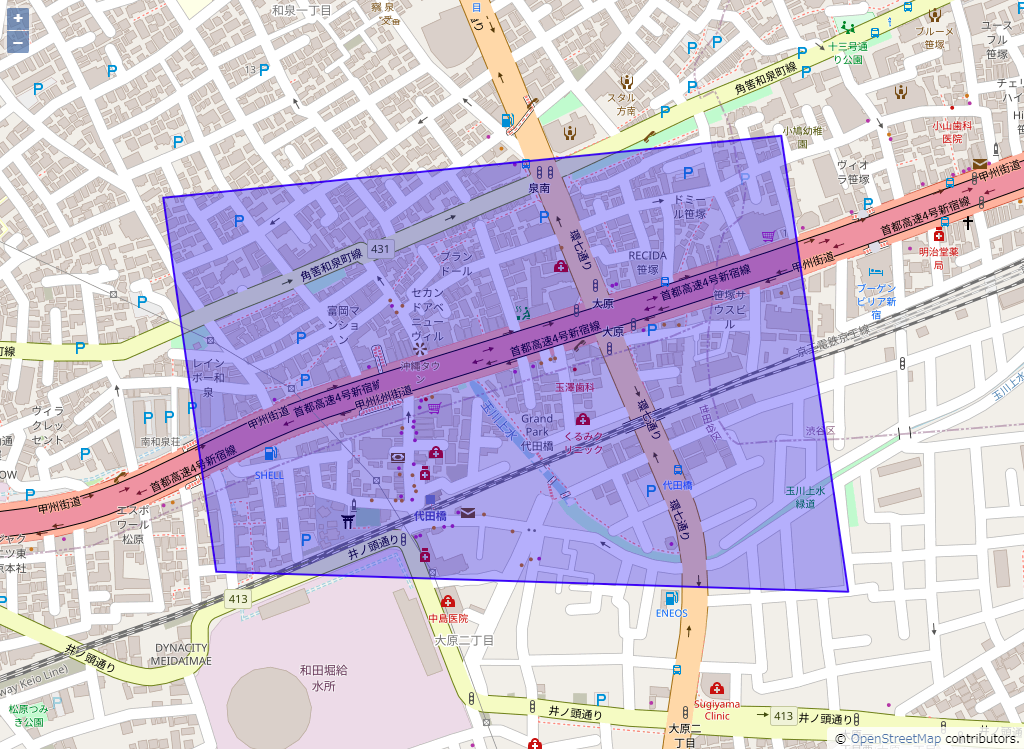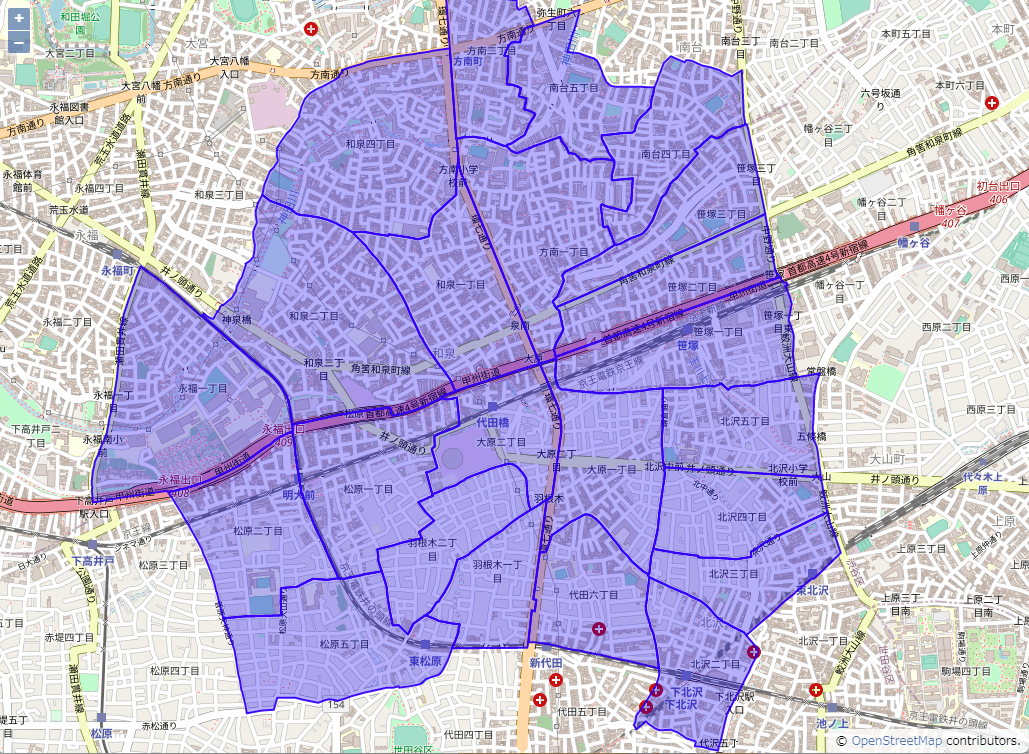OpenLayersを使ってOpenStreetMapに町丁目ポリゴンを表示してみる(OpenLayers v6)
OpenLayersを使ってOpenStreetMapに町丁目ポリゴンを書いてみます。
使用するもの
OpenLayers
Webサイトで地図を扱うときに便利なJavaScriptのライブラリです。動的な地図を使ったWebページの作成が楽にできるようになります。
2022年8月にOpenLayers v7がリリースされましたが、OpenLayers v6を使用した例をあげます。
OpenLayers
OpenStreetMap(OSM)
OpenStreetMap(OSM)は、誰でも自由に地図を使えるよう、みんなでオープンデータの地理情報を作るプロジェクトです。
(OpenStreetMap Japanより引用)
町丁目ポリゴン
町丁目とは行政界の一つで「富士見町3丁目」「広尾1丁目」など「●丁目」で表わされる行政区画のことです。行政界は他には都道府県や市区町村、大字などがあります。
町丁目ポリゴンは町丁目の境界データです。
町丁目ポリゴンはe-statからダウンロードすることもできます。e-statでは小地域(町丁・字等別)という名称で公開されています。
e-statの小地域(町丁・字等別)のポリゴンを地図に描画することもできますが、e-statからダウンロードしたりShapefileやKMLのファイルをシステムに取り込んだりするのが手間なので、マップマーケティングのTerraMap APIを使って取得した町丁目ポリゴンを表示させてみます。
OpenLayers v6 アプリケーションをセットアップ
OpenLayersの公式ページのチュートリアルにある方法をベースに、OpenStreetMapに町丁目ポリゴンを描画してみます。
OpenLayers v6 チュートリアル
npx create-ol-app your-app-name
セットアップ内容の確認
指定した名前のアプリケーションが作成されます。
index.htmlやmain.jsなどのファイルが生成されています。
以下ではmain.jsを変更していきます。
アプリケーションを実行して地図を表示する
こちらもチュートリアルにあるように npm start します。コマンドプロントやVSCodeのターミナルなどから実行します。
表示されたlocalhostのURLにアクセスすると、地図が表示されると思います。
npm start
ポリゴンを地図に表示する
地図ロード時にポリゴンを表示させてみます。
今回はPolygonではなくMultiPolygonで指定してみます。
必要なモジュールをインポートし、VectorSourceにGeoJSONを指定してVectorLayerをセットします。
import './style.css';
import {Map, View} from 'ol';
import TileLayer from 'ol/layer/Tile';
import OSM from 'ol/source/OSM';
import {fromLonLat} from 'ol/proj';
import VectorLayer from 'ol/layer/Vector';
import VectorSource from 'ol/source/Vector';
import GeoJSON from 'ol/format/GeoJSON';
import Style from 'ol/style/Style';
import Stroke from 'ol/style/Stroke';
import Fill from 'ol/style/Fill';
// ポリゴンのスタイルを設定
const styles = {
'MultiPolygon': new Style({
stroke: new Stroke({
color: 'rgba(0, 0, 255, 0.8)',
width: 2
}),
fill: new Fill({
color: 'rgba(0, 0, 255, 0.3)'
})
})
};
const styleFunction = function(feature) {
return styles[feature.getGeometry().getType()];
};
// GeoJSONでポリゴンを準備
const geojsonObject = {
"type": "FeatureCollection",
"features": [
{
"type": "Feature",
"properties": {},
"geometry": {
"type": "MultiPolygon",
"coordinates": [
[
[
[139.65645236269657, 35.6703299404073],
[139.65588373440954, 35.67358963979696],
[139.66251415481307, 35.67413000490703],
[139.6632329867986, 35.67015562118215],
[139.65645236269657, 35.6703299404073]
]
]
]
}
}
]
};
// vectorSourceにGeoJSONをセット
const vectorSource = new VectorSource({
features: new GeoJSON({featureProjection: 'EPSG:3857'}).readFeatures(geojsonObject)
});
const vectorLayer = new VectorLayer({
source: vectorSource,
style: styleFunction
});
const map = new Map({
target: 'map',
layers: [
new TileLayer({
source: new OSM()
}),
vectorLayer
],
view: new View({
center: fromLonLat([139.6596281, 35.6720557]),
zoom: 15
})
});
町丁目ポリゴンを地図に表示する
TerraMap APIから町丁目ポリゴンを取得して表示する
上のサンプルコードでGeoJSONを指定した部分を変更します。
vectorSourceにTerraMap APIにリクエストを送るサーバーサイドプログラムのURLを指定し、ポリゴンを表示させます。
GeoJSONでレスポンスされるため、そのままvectorSourceにセットすることができます。
コード例ではTerraMap APIへのリクエストについて詳細は記載していませんが、指定地点から半径1kmに含まれる町丁目のポリゴンを取得しています。
import './style.css';
import {Map, View} from 'ol';
import TileLayer from 'ol/layer/Tile';
import OSM from 'ol/source/OSM';
import {fromLonLat} from 'ol/proj';
import VectorLayer from 'ol/layer/Vector';
import VectorSource from 'ol/source/Vector';
import GeoJSON from 'ol/format/GeoJSON';
import Style from 'ol/style/Style';
import Stroke from 'ol/style/Stroke';
import Fill from 'ol/style/Fill';
// ポリゴンのスタイルを設定
const styles = {
'MultiPolygon': new Style({
stroke: new Stroke({
color: 'rgba(0, 0, 255, 0.8)',
width: 2
}),
fill: new Fill({
color: 'rgba(0, 0, 255, 0.3)'
})
})
};
const styleFunction = function(feature) {
return styles[feature.getGeometry().getType()];
};
// vectorSourceにTerraMap APIにリクエストを送るサーバーサイドプログラムのURLを指定します。
// URLはダミーです。
const vectorSource = new VectorSource({
url: 'https://your_domain.example.jp/path/to/terramap_api_request_program',
format: new GeoJSON()
});
const vectorLayer = new VectorLayer({
source: vectorSource,
style: styleFunction
});
const map = new Map({
target: 'map',
layers: [
new TileLayer({
source: new OSM()
}),
vectorLayer
],
view: new View({
center: fromLonLat([139.6596281, 35.6720557]),
zoom: 15
})
});

